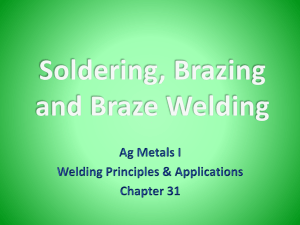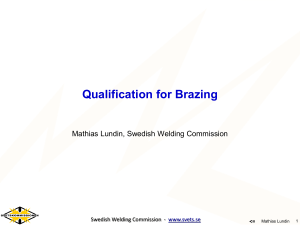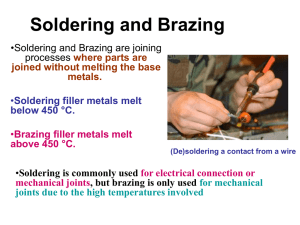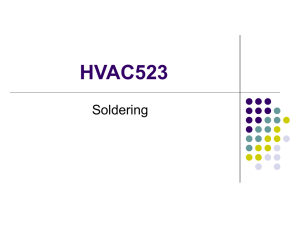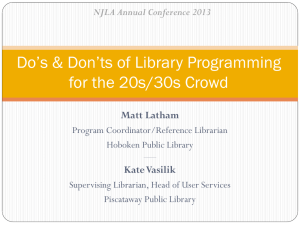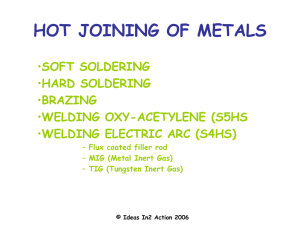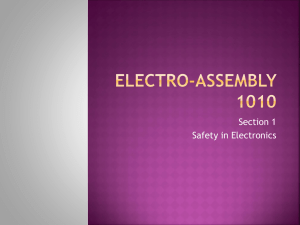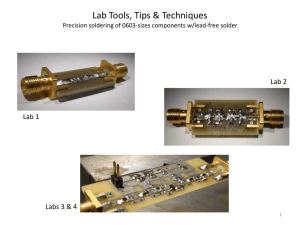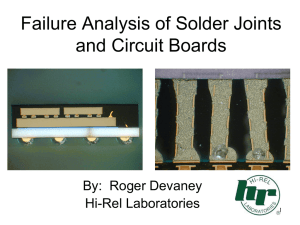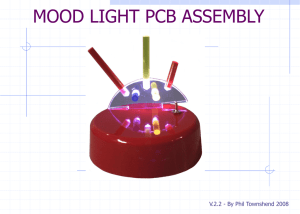soldering & brazing
advertisement
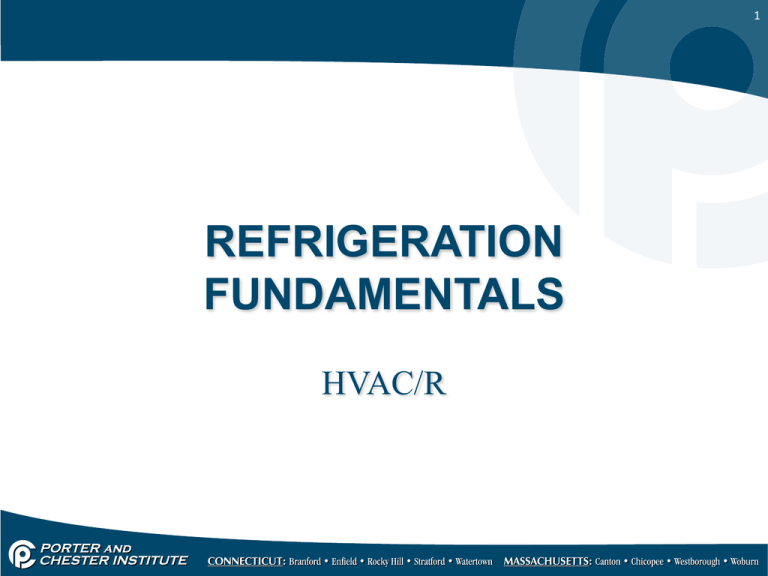
1 REFRIGERATION FUNDAMENTALS HVAC/R 2 SOLDERING & BRAZING • When and why; – When an A/C or refrigeration system is entered, it must be properly sealed – Although flared fittings are widely used, most components are joined by soldering and brazing 3 SOLDERING & BRAZING • Difference between soldering and brazing – Soldering is accomplished with temps under 800°F – Brazing is accomplished with temps over 800°F; usually 1,000°F to 1,500°F 4 SOLDERING & BRAZING • SOLDERING – – – – – Soldering is an adhesion process Solder flows into tubing pores Joining takes place when solder hardens Solder has low tinsel strength It is not recommended for A/C or refrigeration systems due to the high temps and high pressures 5 SOLDERING & BRAZING • SOLDERING – – – – – Soldering is an adhesion process Solder flows into tubing pores Joining takes place when solder hardens Solder has low tinsel strength It is not recommended for A/C or refrigeration systems due to the high temps and high pressures 6 SOLDERING & BRAZING • Newer solder gives tinsel strength of braze and lower melting point of solder – Known as silver bearing solder – StayBright 6 and StayBright 8 – Both contain silver 7 SOLDERING & BRAZING • When soldering, flux must be used – Most common is Solderine • Proper cleaning, fluxing, assembly support, and heating is necessary 1) Clean all surfaces to be soldered 2) use clean flux on all ends 3) Do not overheat 4) Have parts properly supported 8 SOLDERING & BRAZING • The solder has a lower melting point than the copper being joined • Solder should be distributed evenly around and in the joint • Heat the joint evenly, tube and fitting • As flux clears, apply heat directly to the joint 9 SOLDERING & BRAZING • Capillary action will take place, leaving a proper fillet or cap • No globs or drips should be present • Clean joint with a cloth 10 SOLDERING & BRAZING • BRAZING – Brazing is a common practice in HVAC/R – On large applications, oxy-acetylene is used – Most day to day operations can be done with a plumbers torch and acetylene – Brazing is a welding practice 11 SOLDERING & BRAZING • Unlike soldering, brazing can be done to join 2 dissimilar metals • Many different alloys or filler metals are available for HVAC/R work – Most common: • 5% Silver • 15% Silver • 45% Silver 12 SOLDERING & BRAZING • The greater the silver content, the greater the tinsel strength – 5% and 15% are sold by the pound – 45% is sold by the troy ounce • Flux – When brazing, silver flux must be used – It cleans the metal and acts as a temperature indicator – It assists in alloy flow and prevents oxidation 13 SOLDERING & BRAZING • Heat both Fitting and Tube – Flux will turn powdery white and suddenly clear – Clearing is an indication of about 1,100°F • Apply alloy (braze), very little is needed – Capillary action will take place – Alloy (braze) will flow around 1,100°F to 1,250°F • As flow starts, remove alloy and flame 14 SOLDERING & BRAZING • Cool the joint and clean to remove excess flux • Excess flux could hide a pinhole leak 15 SOLDERING & BRAZING • Heating of the joint for soldering and brazing – If heating at the compressor – Do the joint closest to the compressor first, using a wet rag as a heat shield, you could also use heat absorbing paste • Whether soldering or brazing, avoid overheating; glowing red produces scale 16 SOLDERING & BRAZING • EQUIPMENT – Oxy-acetylene • Extremely hot; may also be used for cutting • Not for residential or Roof Top use • Intended for work shop and construction site use 17 SOLDERING & BRAZING • Tanks: – “B” tank or “MC” tank sizes – Can be an unguided missile if not properly secured, the tank is under 250 psi – Impact as little as 15 psi can cause valve to rupture – Tank is cork lined – The valve is opened only ½ turn with a tank wrench 18 SOLDERING & BRAZING • Safety – Always secure the tank – Leak test each time the tank is first opened or changed, using only a bubble solution – Store and use in upright position only • Acetylene is heavier than air; can puddle on floor, removing oxygen from the room, resulting in an explosion hazard 19 SOLDERING & BRAZING • Regulators – 2 types • Adjustable and non-adjustable – Adjustable • Flame is adjusted with the regulator, not the torch handle – Non-Adjustable • Flame must be adjusted with the torch handle, handle is not made for fine tuning 20 SOLDERING & BRAZING • Hose, Handle, and Tip – Should be leak checked when checking the regulator – Tips are interchangeable – New tips are called swirl tips, the give off a hotter flame for brazing larger tubing – Blue tip of flame is the hottest 21 SOLDERING & BRAZING • General Safety – Never use pliers on any part of torch setup – After use: • Shut tank off at valve • Bleed hose • Coil hose – Light torch only using striker – Wear safety glasses at all times – Adjust flame for different sized tubing
